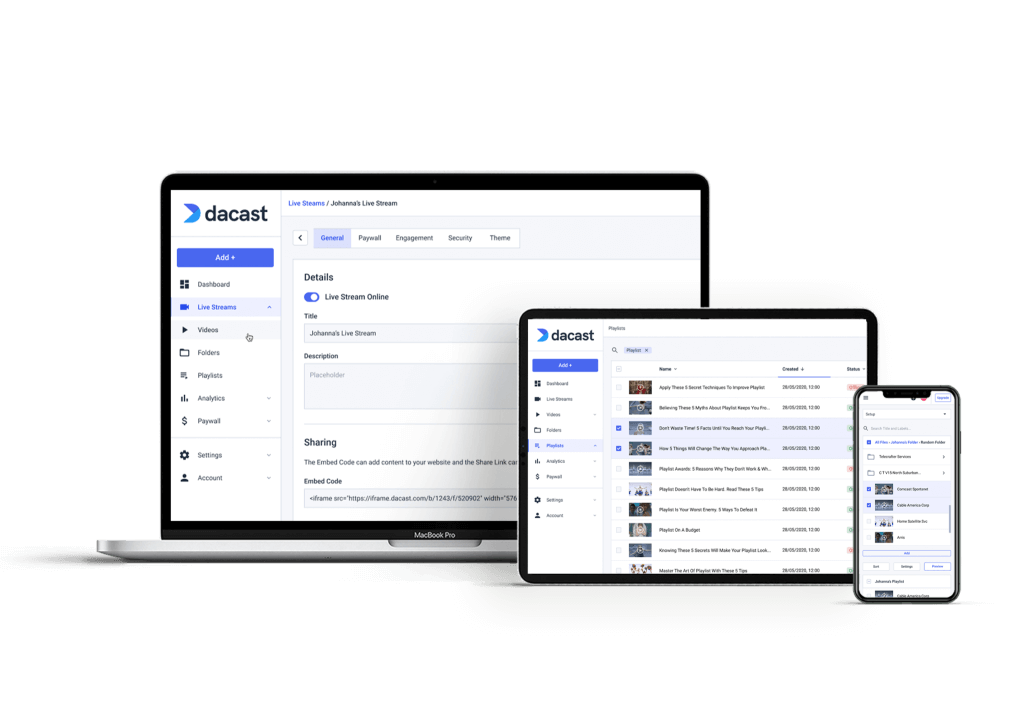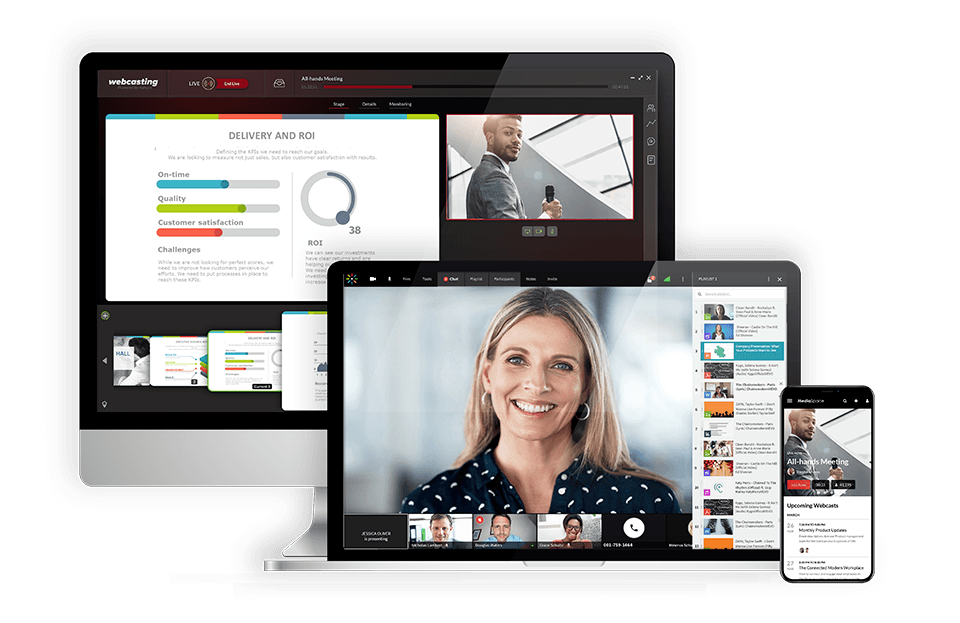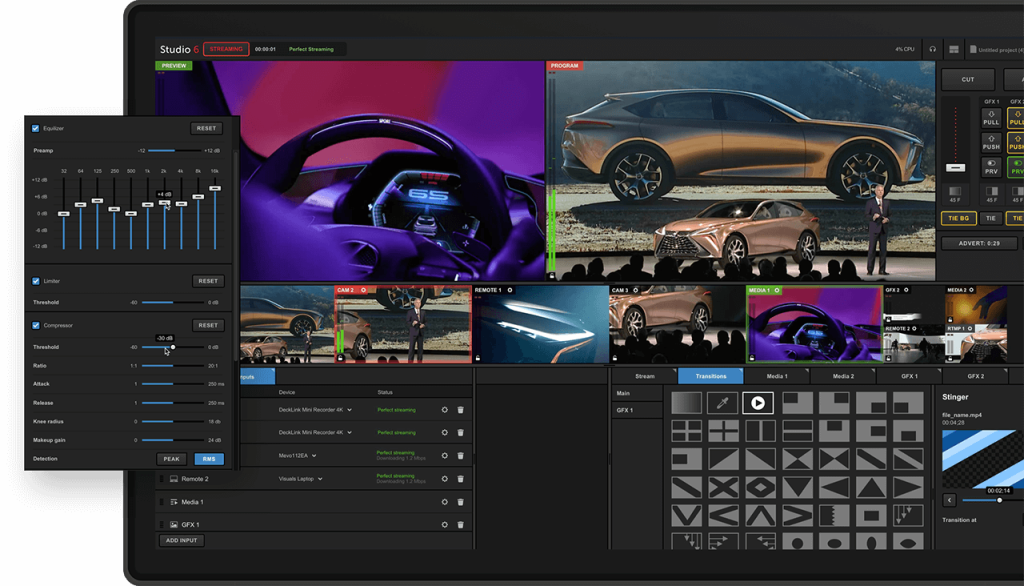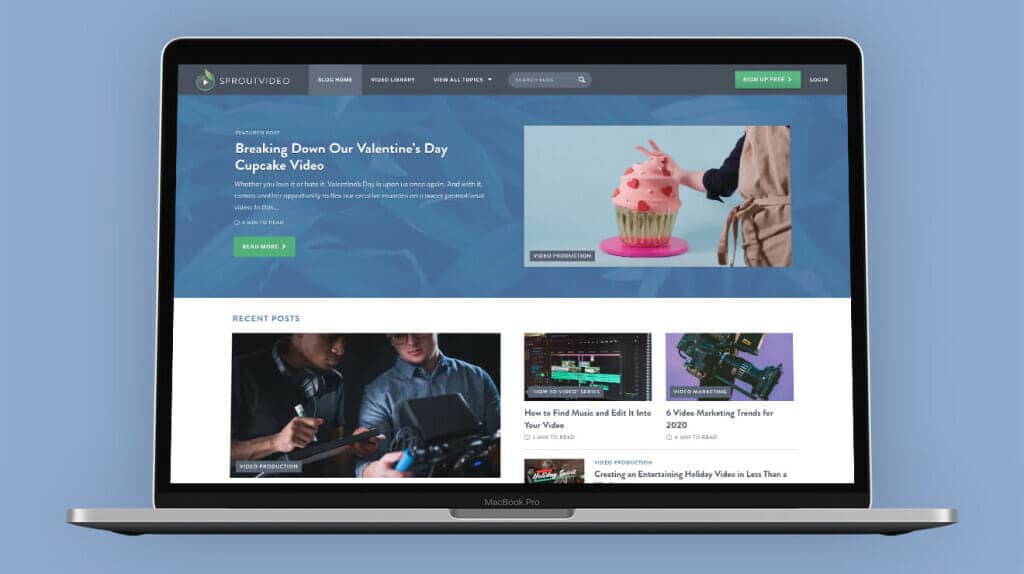The Comprehensive Guide to Cloud Video Platforms In 2022
The cloud is transforming the way broadcasters operate. In fact, many brands are starting to recognize that all-in-one cloud video platforms for live streaming and video on demand (VOD) are more convenient, scalable, and feature-rich than traditional broadcasting technologies.
With this in mind, let’s look at what cloud video platforms are, and the key features that video streaming services should offer. We’ll also take a brief look at the top 12 cloud video platforms on the market in 2022.
Let’s get started and learn more about video cloud platforms
Table of Contents
- What Is a Cloud-Based Video Platform?
- Key Features of Cloud Video Streaming
- Top 12 Online Video Platforms In 2022
- Conclusion
What Is a Cloud-Based Video Platform?

A cloud video platform is a comprehensive solution for streaming live events and on-demand video content. Most of these streaming platforms store video content that’s uploaded by broadcasters or recorded during a live event. These files are encoded or transcoded in the cloud so that they’re ready for delivery to end-users.
Storing videos to the cloud means that you don’t have to store all the content locally on a hard drive. All of the content is virtually stored on the cloud, allowing you to easily access your content by simply logging into your video cloud platform account on any internet-enabled device.
Many cloud video hosting platforms have advanced features that enable broadcasters to better organize and monetize their videos as well. That’s why these solutions are invaluable for today’s brands looking to grow their audience and generate additional revenue.
The best cloud video platforms offer far more than video storage; they offer the ability to control your entire video sharing experience for your business.
Key Features of Cloud Video Streaming
Cloud video platforms vary in quality and depth of functionality, so it’s important to look out for some of these essential features in your next cloud video platform.
1. Cloud Transcoding

Broadcasters need to upload their video on demand content to their cloud video platform before it can be shared with their audience. As part of this process, these files need to be transcoded, so that they’re ready for delivery to a variety of end-user devices. Cloud video transcoding, therefore, is an essential feature for simplifying video streaming workflows.
2. S3 Direct Upload
When it comes to uploading videos, cloud video platforms need secure and robust direct file transfer capabilities. Automated tagging, thumbnail generation, and other convenient features can ensure brands deliver their content to viewers faster. Moreover, bulk uploading can streamline the migration of large video libraries from legacy systems.
S3 direct uploading with your cloud video platform will make it easier for you to control and organize your existing video library, and manage new video content.
3. Video Content Management (CMS)
Once video files are ingested to the cloud video platform, broadcasters need tools for organizing, managing, monetizing, and sharing this content. That’s why an all-in-one solution should include advanced video content management system (CMS) capabilities that enable broadcasters to make the most of their video content in the cloud.
A strong cloud video hosting platform will make it easy for you to organize your content internally and externally for viewers.
4. Cloud Storage
Video content is invaluable for broadcasters, so they’ll want a cloud video platform that can safely store their files. The cloud video platform needs features like password protection, domain restrictions, HLS encryption, and other advanced security measures. These security and privacy features ensure broadcasters can protect their content from data breaches or piracy.
5. Live Recording
While on-demand content is usually uploaded to the cloud platform, broadcasters should also be able to record their live events for playback later as well. Moreover, live recording shouldn’t impact the performance of the live stream itself. Live stream recording in the cloud eliminates the need for powerful hardware or processing power and ensures a high-quality viewing experience.
6. Video Monetization

Broadcasters want straightforward ways to generate revenue from their video content. That means cloud video platforms should give brands monetization options like subscriptions, ad-based video monetization, and pay-per-view that charge viewers using a secure paywall. Every broadcaster should have powerful monetization capabilities for getting the most ROI from their video content.
7. Universal Playback
While APIs ensure broadcasters can deliver their video content anywhere, they should also look for a cloud video platform with universal playback capabilities prebuilt. For example, an HTML5 video player is compatible with nearly any device, so brands can expand their reach and provide high-quality viewing experiences for their audience.
8. Video APIs
A powerful video API is crucial for broadcasters that want complete control over their video streaming workflow. Developers can use APIs to integrate video content into nearly any website, mobile app, business software, or cloud application. Cloud video platforms with APIs available can maximize their use for more advanced business requirements.
9. High-Quality Viewing Experience
Most viewers still expect a TV-quality viewing experience from over-the-top (OTT) broadcasters. Advanced playback features that improve the viewing quality of experiences (QoE) such as chapter markers and playlists can set brands apart from the competition and keep their audience coming back for more.
10. Cost Savings
Cloud video platforms usually have subscription costs based on traffic, storage requirements, and other factors. That said, a cloud platform could substantially reduce video streaming costs compared to traditional streaming workflows. Broadcasters need to choose a platform that offers the features most essential to their business at a reasonable price.
These are ten features you should look for when choosing a cloud video platform for your business’s video hosting and streaming needs.
Comparing the Top 12 Cloud Video Platforms In 2022
Every cloud platform has its advantages and disadvantages, so broadcasters need to determine which features are most important to them. With this in mind, here’s a brief overview of the top streaming platforms currently available.
1. Dacast

Company Background:
Dacast is an enterprise-grade cloud video platform that’s ideal for broadcasters of all sizes and experience levels. The platform has robust cloud storage and streaming capabilities at reasonable prices.
Basic Functionality:
Dacast is a cloud video platform that’s scalable and straightforward to use.
Key Features:
Pros:
- HTML5 video player for adaptive playback
- Live stream recording in the cloud
- China Video Hosting
- 24/7 tech support for all plans
- Positive reviews from customers
Cons:
- A slight learning curve for new users
Upload Guidelines and Specs:
- Minimum dimension: none (but 240p is the recommended minimum)
- Maximum dimension: 1080p or 4K (depends on the user’s hardware and internet)
- Aspect ratio: no restrictions (but 16:9 is the default)
- Max file size: none
- Max video length: none
- Total file storage: 10-1000GB (depends on plan)
- Compatible video formats: MP4 (preferred), MOV, M4V, M2V, AVI, MPG, FLV, WMV, MKV, WEBM, OGV, MXF, ASF, VOB, MT
Pricing:
Dacast has live streaming pricing plans starting at $39/month, including:
- Starter Plan: $39/month (includes 1,000 GB of bandwidth & 50 GB of storage)
- Event Plan: $63/month (includes 6 TB of bandwidth upfront and 50 GB of storage)
- Scale Plan: $188/month (includes 24 TB of bandwidth per year and 1 TB of storage)
- Custom plan: Contact us for custom pricing plans
Best Use Cases:
- Cloud Video Storage for Education
- Enterprise Cloud Video Platform
- Live Video Broadcasting
- Cloud Storage for Video On Demand
Dacast is a strong video cloud platform built for enterprises to use. Dacast offers affordable starter plans for smaller businesses, and custom plans for larger enterprises with big video content needs.
2. Brightcove

Company Background:
Brightcove is a video platform with global users in 70 countries. The platform helps broadcasters integrate marketing, advertising, and communication applications to monetize their video content.
Basic Functionality:
Brightcove’s cloud video platform is built for enterprise-grade video marketing and delivery.
Key Features:
- Live streaming in the cloud
- Over-the-top (OTT) cloud video streaming
- Advertising and marketing capabilities
- Pre-built cloud app integrations
Pros:
- Privacy and security for enterprises
- Intuitive platform interface
- Customer support
Cons:
- No China video delivery
- Limited reporting and analytics tools
- 24/7 support isn’t free
Upload Guidelines and Specs:
- Minimum dimension: Determined by user
- Maximum dimension: Determined by user
- Aspect ratio: No restrictions (since Brightcove uses a responsive player)
- Max file size: No limits on files size
- Max video length: No published limits
- Total file storage: Varies by plan
- Compatible video formats: MP4, MOV, FLV, AVI, WMV, MKV, 3GPP
Pricing:
Brightcove’s pricing is no longer posted, but plans include basic video marketing tools and analytics with SD streaming quality for unlimited viewers.
Brightcove offers three pricing plan levels that target higher-end clients, and include:
- Starter: includes 50 to 200 videos, up to 100,000 plays, and 2-5 users
- Professional: unlimited videos, 100,000+ plays, and no overages plays, with +10 users
- Enterprise: unlimited videos, 100,000+ plays, and no overages plays, with 10+ users, unlimited upload, and analytics-only users
Best Use Cases:
- Cloud streaming live sports
- Enterprise cloud video storage
- Virtual events
Brightcove is a cloud video hosting service that offers marketing, advertising, and communication applications that you can integrate with your video content, with plans designed to support large video libraries.
3. IBM Video Cloud

Company Background:
IBM Video Cloud is a cloud video platform known for its reliable live streaming and video on-demand capabilities, but it’s also more expensive than many alternatives.
Basic Functionality:
IBM Video Cloud provides live streaming and VOD services to enterprise broadcasters.
Key Features:
- Cloud-based live streaming and VOD
- Secure storage and sharing of video content
Pros:
- Feature-rich for broadcasters
- Enterprise-grade reliability
- Customer support
- Hong Kong (China) cloud video hosting
Cons:
- Limited tools for monetization
- Doesn’t use a CDN
- No APIs available in general plans
Upload Guidelines and Specs:
- Minimum dimension: 480p (480 x 270)
- Maximum dimension: 4K (3840 x 2160)
- Aspect ratio: No published aspect ratio
- Max file size: 4 GB
- Max video length: No published limits
- Total file storage: 1TB – 5TB (depends on plan)
- Compatible video formats: MKV, MP4, MOV, FLV, AVI, WMV, MPEG2, H264, H263, MPEG4, VP6, VP8, THEORA, WMV, MP3, AAC-LC, NELLYMOSER, PCM, SPEEX, VORBIS, WMA
Pricing:
IBM pricing plans range from $99 to $999 per month and include the following:
- Silver: $99/month
- Gold: $499/month
- Platinum: $999/month
- Custom: Please contact IBM Cloud video for custom plan pricing.
Best Use Cases:
- Marketing and enterprise cloud video storage
- Media & Entertainment video streaming
- Virtual event streaming in the cloud
IBM Cloud Video is a cloud video platform that offers affordable plans and lots of rich features for broadcasters.
4. Kaltura

Company Background:
Kaltura is an Israeli video company that offers a cloud video platform with live streaming and VOD capabilities for large institutions.
Basic Functionality:
Kaltura provides video streaming services for employers and universities that want to deliver educational content to employees and students.
Key Features:
- Kaltura Cloud for cloud storage
- Cloud TV services
- Enterprise-grade security
Pros:
- Great for education and enterprise broadcasting
- Hands-off SaaS solution
- Multiple monetization options
Cons:
- Substantial learning curve
- Slow video uploading and processing
- No China delivery
Upload Guidelines and Specs:
- Minimum dimension: 180p (320 x 180)
- Maximum dimension: 1080p (1920x 1080)
- Aspect ratio: 16:9, 4:3
- Max file size: 2GB
- Max video length: Not available
- Total file storage: 10GB to Unlimited (depends on the plan)
- Compatible video formats: MOV, MP4
Pricing:
Kaltura pricing is based on bandwidth and feature usage, but there are free trials available.
Best Use Cases:
- Enterprise and education video streaming
- Cloud video streaming for sales
- Live event streaming
If you are an educational business looking for a cloud video platform, Kaltura is a strong choice. They have numerous educational clients and lots of integrations and customizations designed to serve the educational market.
5. Wistia

Company Background:
Wistia is a cloud video platform for creating, managing and delivering video content.
Basic Functionality:
Wistia provides a variety of TV-quality video streaming and other features, including custom branding, annotation links, CTAs, and more.
Key Features:
- Cloud video storage and management
- Channels and “up-next” options
- Interactive cloud video tooling
Pros:
- Custom branding
- Advanced analytics
- Cloud video organization
- Customer support
Cons:
- Issues with some customization features
- No China video delivery
Upload Guidelines and Specs:
- Minimum dimensions: None
- Maximum dimensions: Maximum of 4K (3840 x 2160)
- Supported aspect ratios: Any
- Maximum file size: 8 GB
- Maximum video length: 2 hours
- Total file storage: Up to 10 videos with the pro plan ($99 per month), $0.25 per month for every extra video
- Accepted video formats: MP4 (recommended format), .MOV, .AVI, .WMV, .FLV, .MKV, 3GPP
Pricing:
Wistia has multiple pricing options, including:
- Basic plan: Free
- Pro plan: $99/month
- Advanced: Please contact Wistia directly for pricing information.
Best Use Cases:
- Enterprise and marketing cloud video streaming
- Cloud-based virtual classroom streaming
- Video CMS
Wistia is a great cloud video platform if you are creating marketing videos. Their platform has multiple integrations that make working with marketing videos easier.
6. Vidyard

Company Background:
Vidyard is a cloud video platform with the tools needed for professional video streaming. This includes multiple packages based on use-cases, such as marketing, sales, and corporate communications.
Basic Functionality:
Vidyard is an all-in-one platform for delivering video content that converts viewers into customers.
Key Features:
- Advanced security for cloud platform
- Cloud videos storage
Pros:
- Cloud integrations
- Active user community
- Great customer service
Cons:
- Complicated backend
- Issues with consistency
- No China delivery
Upload Guidelines and Specs:
- Minimum dimension: 360p (480 x 360)
- Maximum dimension: 4k (3840 x 2160)
- Aspect ratio: 16:9, 4:3
- Max file size:5GB to 16GB (depends on the plan)
- Max video length: 1 hour (live stream)
- Total file storage: Not available
- Compatible video formats: WEBM, MP4, MKV, MOV
Pricing:
Vidyard pricing plans come in four tiers, split amongst two categories: Individual and Teams.
They are broken down as follows:
- Individual
- Free – $0/month
- Pro – $15/month
- Teams
- Teams – $300/month
- Business – $1250/month
- Custom Video Solutions:
- All enterprise pricing packages are custom priced.
Please note that all plans are billed annually.
Best Use Cases:
- Marketing cloud video storage
- Enterprise cloud hosting
- Cloud video streaming for sales
Vidyard is another strong cloud video platform for marketing and sales purposes.
7. DailyMotion

Company Background:
DailyMotion is a cloud video platform for storing and streaming video content.
Basic Functionality:
DailyMotion has simple features for video hosting and delivery in the cloud.
Key Features:
- Integration with gaming platforms
- Cloud video infrastructure
- Supports 35 countries and 18 languages
Pros:
- Unlimited cloud storage and bandwidth
- Support for global audiences
- China video delivery with Huawei partnership
Cons:
- No support for private cloud video hosting
- Limits on video file size and duration
Upload Guidelines and Specs:
- Minimum dimension: 240p (426 x 240)
- Maximum dimension: 4K (3840 x 2160)
- Aspect ratio: 16:9 (adds padding to videos with other aspect ratios)
- Max file size: 128GB
- Max video length: 12 hours
- Total file storage: Unlimited
- Compatible video formats: MOV, MPEG4, MP4, AVI, WMV, MPEG-PS, FLV, 3GPP, WebM
Pricing:
DailyMotion is a free cloud video platform but offers paid plans to increase video exposure.
Best Use Cases:
- Public cloud video hosting
- Live streaming videos in the cloud
DailyMotion is a free cloud video platform that is often compared to YouTube, with fewer content restrictions and rules. They also offer paid plans that help you with sharing your video content with more viewers.
8. JWPlayer

Company Background:
JWPlayer is a cloud video platform with live streaming and VOD features. The platform is geared towards companies with lower budgets.
Basic Functionality:
JWPlayer offers limited cloud video storage and streaming at low price points.
Key Features:
- Cloud streaming to any device
- Video storage in the cloud
- Suitable for broadcasters with budget constraints
Pros:
- Affordable
- Great customer support
Cons:
- Live events limited to 5 hours
- Lack of APIs available for live streaming
- No China delivery
Upload Guidelines and Specs:
- Minimum dimension: 360p (640 x 360)
- Maximum dimension: 1080p (1920 x 1080)
- Aspect ratio: 16:9, 4:3, 2.39:1
- Max file size: 25GB
- Max video length: Not available
- Total file storage: 25GB to 500GB (depends on the plan)
- Compatible video formats: MP4, WMV, AVI, MOV, 3GP, FLV
Pricing:
With JW Player, live streaming support begins at a free trial level. There are 3 pricing plan tiers:
- 30-day free trial subscription which includes full API and SDK access, and a non-commercial license, with 25 GB hosting bandwidth and 75 GB streaming.
- Starter pricing plan for $10 per month, which includes an HTML5 Video Player and video gallery, with 150 GB hosting bandwidth and 500 GB streaming (50,000 plays) per month billed annually.
- Enterprise plans are available with custom pricing for high-volume storage and streaming. Enterprise plans support live streaming, while lower-tier plans only support VOD.
Publishers and broadcasters should contact JW Player directly for pricing and features.
Best Use Cases:
- Cloud streaming digital media
- Enterprise and marketing cloud video hosting
JW Player is a solid cloud video hosting solution if you are looking for an easy-to-use platform.
9. Livestream (Vimeo)

Company Background:
Livestream is a cloud video platform by Vimeo. Large organizations can use the platform’s advanced marketing features for live event streaming.
Basic Functionality:
Livestream has all the tools organizations need to stream, manage, and monitor videos.
Key Features:
- Cloud video management
- Live streaming in the cloud
- Advanced marketing tools
- Audience interaction features
Pros:
- Easy for users and viewers to use
- In-depth analytics available
- Integrates directly with YouTube
Cons:
- Software updates sometimes interrupt streams
- Limited CDN support
- No China video streaming
Upload Guidelines and Specs:
- Recommended dimension: 720p (1280 x 720)
- Aspect ratio: 16:9, 4:3
- Max file size: 3GB
- Max video length: Information not available
- Total file storage: Information not available
- Compatible video formats: MP4 (recommended)
Pricing:
Vimeo Livestream offers three main pricing plans, including:
Vimeo Premium:
- Premium pricing: $75/month
- Their Premium plan includes both live streaming and VOD services. This plan is the way to go for professional broadcasting.
Vimeo Enterprise:
- Enterprise Pricing: Please contact Vimeo for custom pricing information
- The Enterprise plan includes white-label service, monetization, and video APIs. It also includes branding control and added security features.
Vimeo OTT:
- Starter Pricing: $1/subscriber per month
- Growth Pricing: starting at $500/month
- The OTT-specific pricing packages come with the Vimeo.com relationship. These plans include all the basics for starting your web-based OTT channel, as well as growing your Vimeo OTT business online.
For more details, check out our comprehensive guide to Vimeo Livestream pricing.
Best Use Cases:
- Live event streaming
- Cloud video hosting for marketing
10. Panopto

Company Background:
Panopto is a cloud video platform geared towards businesses and universities. There are over 5 million Panopto users in the global eLearning space.
Basic Functionality:
Panopto integrates with learning management systems (LMSs) to organize and stream educational videos more efficiently in the cloud.
Key Features:
- Live streaming and recording in the cloud
- Cloud video storage and management
- Mobile-ready video solution
- White-label video streaming
Pros:
- Regional cloud infrastructure
- Support for both video and audio content
- Custom branding options
- China video streaming
Cons:
- No version control
- No SEO management
Upload Guidelines and Specs:
- Minimum dimension: 240p (426 x 240)
- Maximum dimension: 4K (3840 x 2160)
- Aspect ratio: 16:9, 4:3
- Max video length: Information not available
- Total file storage: Information not available
- Compatible video formats: AVI, MP4, MPG, WMV, MOV, QT, ASF, 3GP, WMA, MP3, M4V, and more.
Pricing:
Panopto overs three different pricing packages, including:
- Basic: Free
- Pro: $14.99/month
- Enterprise: Please contact Panopto for custom pricing.
After establishing a contract, you have access to unlimited streaming and storage.
Best Use Cases:
- eLearning video streaming
- Cloud video streaming for education
- Cloud hosting for corporate training videos
Panopto is a cloud video platform with a focus on eLearning and video streaming for education and corporate training. If your business falls within these categories, Panopto is a great choice!
11. SproutVideo

Company Background:
SproutVideo is a cloud video platform with bare-bones plans up to a fully-featured video solution.
Basic Functionality:
SproutVideo offers live and on-demand video streaming using its cloud platform.
Key Features:
- Live streaming hosting for the video cloud
- Advanced security and privacy capabilities
- Live chat support
Pros:
- Plan options for every budget
- In-depth analytics features
Cons:
- Limited cloud storage for lower plans
- Buffering issues
- No China video delivery
Upload Guidelines and Specs:
- Minimum dimension: None
- Maximum dimension: None
- Supported aspect ratios: Any
- Maximum file size: Up to 100 GB
- Maximum video length: Unlimited
- Total file storage: 500 GB
- Accepted video formats: MP4, MOV, AVI, WMV, FLV, MKV, 3GPP
Pricing:
SproutVideo has multiple plans:
SproutVideo offers four pricing plans:
- Seed: $24.99/month; best suited for broadcasters who don’t need many tools or functions
- Sprout: $59.99/month; comes with additional privacy tools
- Tree: $199.99/month; great for secure embedding
- Forest: $499.99/month; fully loaded with the features an advanced broadcaster would need
SproutVideo has a great breakdown and comparison of their plans on their pricing page. Please check this page for additional fees for storage and hosting.
There’s also a 30-day trial available.
Best Use Cases:
- Enterprise video streaming in the cloud
- Cloud-based live event streaming
- VOD cloud hosting
SproutVideo is a strong cloud video platform for enterprises. If you want all the features though, you need to be willing to invest in the highest level pricing plan for advanced broadcasting features.
12. Vimeo Live

Company Background:
Vimeo Live is a cloud video platform for live event streaming. The platform is reliable and includes professional tools for broadcasters.
Basic Functionality:
Vimeo Live is a comprehensive platform for cloud storage and video streaming.
Key Features:
- Video hosting in the cloud
- Live event streaming
- Advanced video distribution and marketing features
Pros:
- Easy to get started
- Unlimited events and viewers
- Intuitive interface
Cons:
- Some issues with connections to an internal server
- No China video streaming
Upload Guidelines and Specs:
- Recommended dimension: 720p (1280 x 720)
- Aspect ratio: 16:9, 4:3
- Max file size: 3GB
- Max video length: Information not available
- Total file storage: Information not available
- Compatible video formats: MP4 (recommended)
Pricing:
Vimeo offers basic cloud video plans that are suitable for content creators and startups.
- Basic: 30-day free trial
- Plus: $7/month; 5GB/week or 250GB every year; Single user; Brand customization and privacy tools
- Pro: $20/month; 20GB/week or 1TB every year; 3 users; collaboration tools and video showcase sites
- Premium: $75/month; Unlimited live streaming with 7TB of storage; unlimited viewers
- Enterprise: Custom-priced, custom-built plans for advanced streaming needs
All plans are billed annually. The Plus plan can be billed monthly at an increased rate of $12/month.
Best Use Cases:
- Enterprise and marketing cloud video hosting
- Cloud streaming for sales
- Live event streaming in the cloud
Conclusion
With so many cloud video platforms available in 2022, choosing the right solution can be hard. Broadcasters should determine which features are most important for their business hosting needs before weighing the options.
For many broadcasters, the Dacast online video platform (OVP) fits the bill. We also offer a 14-day free trial of Dacast, with no credit card required. Click here to sign up now and test the platform yourself.
Thanks for reading, and let us know your questions and feedback in the comment section below. We love to hear from our readers, and we’ll get back to you as soon as we can.
For more regular tips on live streaming, as well as exclusive offers, you can join our LinkedIn group.
 Stream
Stream Connect
Connect Manage
Manage Measure
Measure Events
Events Business
Business Organizations
Organizations Entertainment and Media
Entertainment and Media API
API Tools
Tools Learning Center
Learning Center Support
Support Support Articles
Support Articles